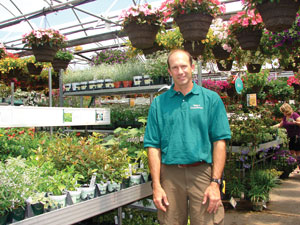11/15/2009
Saving Money in Tight Times
Barbara Mulhern

How does a retail grower save tens of thousands of dollars in order to turn a healthy profit in tight economic times?
For George Papadelis, owner of Telly’s Greenhouse in Troy, Michigan, its been through a combination of buying items in bulk, making use of a point-of-sale system, re-negotiating workers’ compensation insurance rates, and decreasing transportation-related costs.
“We saved between $30,000 and $40,000 this year on everything,” says George, who projects that 2009 will be a “very profitable” year. “Re-negotiating our workers’ compensation rates saved $14,000. And since 2005, we have had a point-of-sale system in place. That alone saves us thousands of dollars every year.”
George, who has been growing plants since he was 11 years old, says his dad bought the property where Telly’s is located in 1977. George started growing full-time on his own in 1988.
Troy, which George describes as “pretty rural 30-some years ago,” later became a “bedroom community to Detroit.” Now, however, Troy is its own city, and most of George’s customers are within a 10-mile radius of the greenhouse operation.
Telly’s customers are predominantly high-end homeowners, although they also include a few landscape contractors with high-end projects who want unusual plants.
“We offer a little more value than our competitors,” says George, whose wide varieties of products include annuals, perennials, roses, herbs, vegetables, bonsai and tropical plants. “We have people who come in and are on a pretty tight budget. So, for example, we sell 12-in. fiber hanging baskets for $19.99 versus others selling them for $25 or $30. We sell at a very competitive high-value price.”
Watching the pennies
George says the way he makes money during both good and tight economic times is by “watching the pennies. Since I’m right here every hour of the day I know what everybody is doing all the time. We keep the exact number of employees we need at any given time.”
Telly’s retails its plants in Troy, but grows them in Willis, about 50 miles away. This year, Telly’s began doing all of its transplanting in Troy instead of sending the plugs and plantings to Willis.
“This allowed me and other people who would be hanging out waiting for customers to work on those instead,” George says. In addition to being more time-efficient, it also eliminated the travel-related costs of sending some of Telly’s employees to Willis. The decrease in gas and fuel expenses alone has saved George more than $12,000 this year. “We have fewer vehicles going back and forth,” he notes.
Additional ways Telly’s has saved money this year include:
• Purchasing soil in bulk. “Before, we bought bales,” George says.
• Decreasing the size of its printed spring flyer. The smaller flyer sends customers and potential customers to Telly’s website “where we can show them way more,” he says.
• Continuing to make good use of its point-of-sale system. “Everything has a unique bar code,” George says. “With that information, I know how many of each plant is being sold so we can cater our production very specifically to what our point-of-sale system shows.” The system also helps him know exactly when each product is likely to sell. “We have the entire history for each customer in our system. We go to the system to see what that customer bought last year,” he says.
Marketing tips
As a retail grower, George knows how important it is to continuously market his business. One of the most important tips he has for other small retail growers is to have a very knowledgeable staff. Some of Telly’s employees have traveled around the country and to China to see new plants there. “My hardgoods guy knows his products like the back of his hand,” George says. “He also presents classes to the rest of the staff.”
George has these additional marketing tips:
Look for opportunities to promote your business in local and statewide trade publications. “We advertise in Michigan Gardener magazine,” George says. “We have the inside cover where we promote our classes and some of our new plants.” He also writes a column called “Plant Focus” that appears in the magazine eight months out of the year. The column covers a different genus each time. “People will come in and ask us for these plants. I write a new annuals article every May and a new perennials article in June. This is getting us more customers and is establishing us as the place to go to see the cool new plants,” he says.
Try to plant new and unusual plants in public locations. One example of this is a landscape contractor customer who wanted some new “fun” plants for a nearby mall. Quite a few of George’s customers saw the plants. This gave him a chance to evaluate how the plants were growing while also generating interest in the plants among other potential customers.
Establish your greenhouse operation as the place for customers to get the information they need. “A little over a year ago we set up an information center at our store. We have a big sign that says ‘Information’ and a computer terminal with a big screen,” George says. Customers who are looking for additional information about a plant or anything else related to plants can use the computer to look it up. The computer terminal is centrally located in the store just 40 to 50 ft. from the cash registers.
Barbara Mulhern is a freelance writer from Verona, Wisconsin.